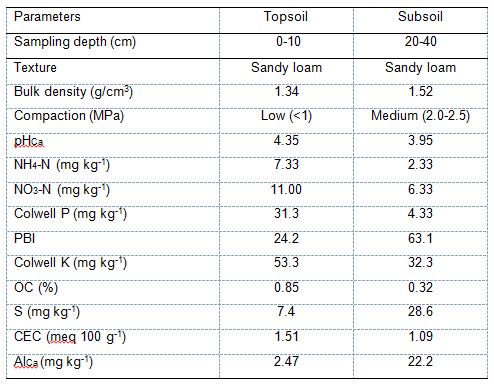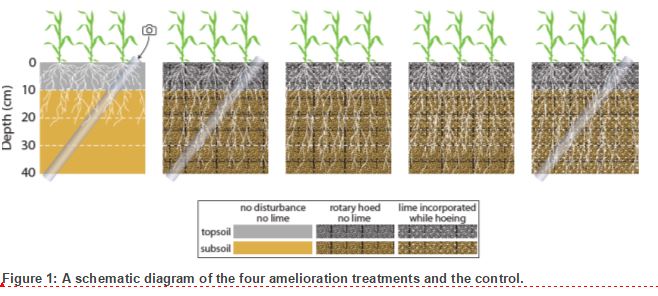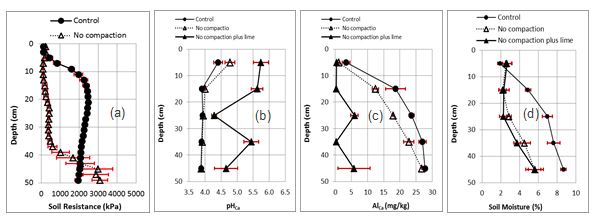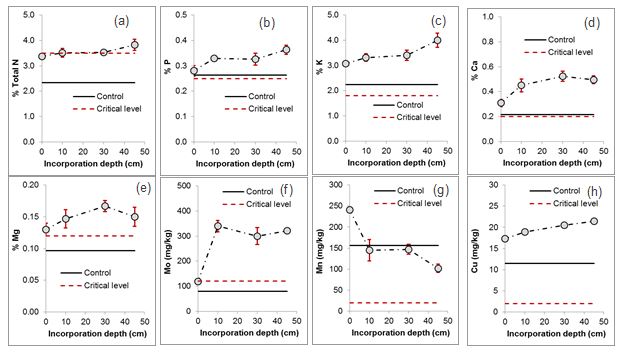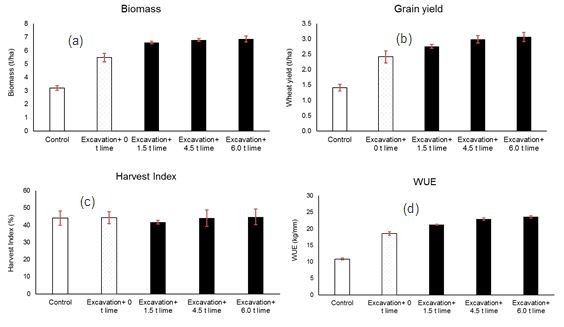Deep soil re-engineering to optimise grain yield under low rainfall conditions
Author: Gaus Azam, Chris Gazey and Richard Bowles (Department of Primary Industries and Regional Development, Northam, Western Australia). | Date: 25 Feb 2019
Key messages
- Wheat grain yield was doubled and water use efficiency (WUE) was as high as 24 kg per mm due to deep amelioration of soil compaction and acidity in the low rainfall region of WA.
- Deep incorporation of lime increased soil pH by more than a unit and decreased Al concentration to below toxic levels within two months of lime application.
- Wheat plants produced root systems 60-65 cm deep with deep amelioration of compaction and acidity compared to 20-25 cm deep for the untreated control. Deeper roots allowed plants to extract soil water and nutrients from deeper soil horizons and avoid moisture stress, in absence of sufficient rainfall, during the grain filling stage.
Aims
More than 70% of topsoil samples and almost 50% of subsurface (10-20 and 20-30 cm) layer samples collected from the WA wheatbelt were below the minimum recommended pH targets of 5.5 and 4.8 (Gazey et al., 2013). These soils are acidic due to the historic contribution of the leguminous native plants and/or due to intensive use of ammonium based fertilisers and export of food and fibre from the farm. Conventional application of surface applied agricultural lime to treat acidic soil takes many years to improve soil pH deeper in the soil profile (Li et al., 2019) and increase crop yield (Whitten, 2002). While grain yield increases occur, the number of years that elapse before yield improves, and economic benefit is realised, is a barrier for many growers. Therefore, growers are looking for more rapid methods to correct subsurface soil acidity.
A large proportion of acidic sandplain is also compacted (van Gool 2011). Literature suggests that physical incorporation of lime through tillage operations to an acidic soil could be the most effective way of improving soil pH while reducing soil compaction (Davies 2014). Scanlan et al (2014) suggested that if an efficient tillage operation is used mix to the depth where the soil pH constraint occurs then an immediate payback on lime and cultivation is possible. However, currently used soil amelioration practices (e.g. deep ripping, liming) are found to partially remediate soil acidity and compaction. Such soil renovation generates variable crop yield responses as we observed from various long-term field trials (Davies 2018).
In paddocks where multiple soil constrains such as compaction and subsoil acidity are present, most crop roots are confined within 20-30 cm of the surface. With such shallow roots a large proportion of growing season rainfall quickly drains away beyond the root zone. The aim of this filed trial was to test whether ‘Re-engineering’ (deep tillage and lime incorporation) soils profile with multiple constraints can significantly improve rooting depth of grain crop towards optimising water use efficiency (WUE) and grain yield. The trial was conducted in a paddock near Kalannie, Western Australia, where a wheat crop was grown in small plots under no soil constraints (to an approximate depth of 45 cm) to quantify the yield potential and WUE of wheat on an ameliorated acidic sandplain.
Method
Trial description
This is on-going field trial established in a continuously cropped paddock of Bob and Amanda Nixon in Kalannie, Western Australia (35°42’S, 117°29’E). The soil is classified as a Yellow-orthic acidic Tenosol in the Australian Soil Classification. Soils in this region were naturally acidic before being cleared for use in agriculture. These soils are also locally known as Wodjil soils. Some physical and chemical properties of the soil profile (two depths), measured before setting up the trial, are given in Table 1.
The trial was established in April 2018 and consisted small plots of 3 x 2 m size with a randomised block design, replicated three times. There were five soil amelioration treatments comprising an untreated control (T0) and four treatments involving either removal of compaction only (T1) or removal of both compaction and acidity (T2, T3 and T4). The amelioration process involved grading and incorporation 1.5 t ha-1 of lime for each 10 cm soil layer (Fig. 1). There were a total of 12 control plots, four per replicate, paired with one of the plots in the other four treatments.
For the four amelioration treatments (T1-T4), two soil horizons (0-10 and 10-30 cm depths) were graded and kept separate for later re-spreading. A third horizon (30-45 cm depth) was then spaded in situ using a small rotary hoe to a depth of approximately 30-45 cm. For T4, 1.5 t/ha lime was spread on top of the third horizon before spading. The second horizon (10-30 cm depth) was then back-filled and 3 t/ha lime was applied for T3 and T4 before all the plots were rotary hoed. Top soil was then returned and 1.5 t/ha lime was applied to the plots of T2, T3 and T4 before all the plots were rotary hoed. The lime used had 94.9% neutralising value with 99.2% < 0.5 mm particle size.
Table 1. Properties of top and subsoils used in the experiments.
The trial was sown to c.v. Mace wheat at 60 kg/ha. All plots were fertilised with MAP, SOP and Urea (37, 100 and 57 kg/ha respectively) at sowing. Pre-sowing herbicide program consisted: Triflur 2 L/ha, Sprayseed 250 2 L/ha, Sakura 118 g/ha. After plant emergence Velocity (670 ml/ha) and MSO (1%), were also applied.
Soil profile moisture content was repeatedly measured from all plots during the growing season using PVC access tubes and a Diviner 2000 (Sentek Technology, Adelaide, SA). Wheat root architecture was also imaged repeatedly in situ using a clear glass tubes (Rhizo tubes, ICT International, Armidale, NSW) and a 360° scanner (CI-600, CID Bio-Science, Camas, Washington, USA). NDVI data were collected at the tillering stage. In spring 2018, soil profile samples were collected at 0-10, 10-20, 20-30, 30-40 and 40-60 cm depths from each plot. Plant samples were collected at the tillering and Z65 growing stages for measuring nutrient uptake. The wheat crop was harvested by hand-cuts for measuring number of tillers, biomass and grain yields.
A linear model was fitted to each of the measurements using the ANOVA procedure in GenStat (Version 18.1, VSN International, Oxford, UK) to compare the treatment effects with polynomial contrasts. Fisher's protected least significant difference (LSD) was applied at the 0.05 significance level.
Results
Rainfall and temperature in 2018
Season 2018 began with average rainfall but the rainfall in spring, especially the month of September, was well below average (7 mm, Fig. 2a). The total rainfall for the shortened growing season (May-September) was 187 mm. There were only two days with negative air temperature and these were not low enough to cause crop damage (Fig. 2b).
Figure 2: (a) Monthly total rainfall, and (b) daily minimum and maximum temperatures at the trial site in 2018.
Soil excavation completely removed compaction to the depth of excavation (Fig. 3a). Lime incorporation lifted soil pH of the treated soil horizons well above the minimum recommended pHCa of 5.5 in the surface and 4.8 in the subsurface (Fig. 3b). Liming also decreased total Al from a very toxic range (18-27 mg/kg in the control subsoil) to a non-toxic level of <5 mg/kg (Fig. 3c).
Figure 3: (a) Soil strength on 18 May, (b) Soil pHCa on 08 August, (c) Soil aluminium on 08 August, and (d) Soil moisture on 23 August.
Figure 4: Concentration of (a) total N, (b) P, (c) K, (d) Ca, (e) Mg, (f) Mo, (g) Mn and (h) Cu in wheat tissue at tillering. Incorporation depths, on X-axis, correspond to T1 (0 t lime and incorporation only), T2 (1.5 t lime incorporated to 10 cm depth), T3 (4.5 t lime incorporated to 30 cm depth) and T4 (6 t lime incorporated to around 45 cm depth). Vertical bars represent ± standard error of the mean nutrient concentration.
Due to the above improvement in soil chemistry and physics, there was significant improvement in root growth. Root growth was restricted to within 20-25 cm depth for the unameliorated control. For treatments T1-T4 wheat roots grew up to 60-65 cm depth, where lime was incorporated at depths (T3 and T4), there were more fine roots and roots hairs in the deeper horizons. The wheat crop growing on ameliorated soil profiles was found to extract more water (Fig. 3d) and nutrients (Fig. 4). In the untreated control plots a large proportion of the soil water remained unused (Fig. 3d).
Liming significantly increased N, P, K, Ca, Mg, Mo and Cu concentration in wheat tissue at tillering stage. Lime and incorporation had some negative effect on Mn and Zn concentration in wheat tissue, but their concentrations were still higher than the critical levels.
Plant biomass production in the ameliorated soil profiles was doubled (Fig. 5a). This improvement in biomass production did not affect the grain filling (i.e., harvest index was not different, Fig. 5c) despite having a dry month of September (Fig. 2a). Ultimately, wheat grain was more than double in the deep lime incorporated treatment compared to the untreated control (Fig. 5b). Incorporation of 6 t/ha lime to 0-45 cm depth was significant better than the incorporation of 1.5 t/ha lime to 0-10 cm soil. T1 (removal of compaction only) also increased grain yield by 70% compared to the untreated control. WUE was also doubled (24 kg/mm) compared to the untreated control (11 kg/mm). These improvements in plant growth, grain yield and WUE strongly correlated with depth of amelioration of in soil acidity and compaction.
Figure 5: Improvement in wheat (a) biomass, (b) grain yield, (c) harvest index and, (d) water use efficiency in 2018 due deep incorporation of lime. Vertical bars represent ± standard error of the mean values of the respected parameters. Scales on Y-axes are different due to differences in response of different parameters.
Conclusion
Our results suggest that deep incorporation of lime increased soil pH by more than a unit within two months of lime application. This improvement in soil pH also decreased Al concentration to a completely non-toxic level. Complete removal of compaction (by grading and back-filling) and lime incorporation produced deep root systems (with fine roots and root hairs), which allowed plants to extract soil water and nutrients from deeper soil horizons (Scanlan et al., 2014). With the above improvement in soil chemistry as well as water and nutrient uptake, plants growth was improved significantly. In addition, plants growing in ameliorated plots were not susceptible to the dry finish of the season 2018.
This trial demonstrated that deep amelioration of soil compaction and acidity could double the wheat grain yield, which exceeded the modelled yield potentials for the low rainfall region of WA, reported in van Gool (2001) and Lawes et al. (2018). The WUE of the wheat crop was as high as 24 kg per mm rainfall, which surpassed the expectation of the local grower. Data will be collected from the trial in 2019 and 2020 to quantify the longevity of the benefits. Although it is currently difficult to replicate these soil amelioration treatments to a farmer’s scale practice, the findings from this trial will benchmark the maximum grain yield potential at the site.
References
Davies, S. (2014). Long-term crop responses to soil inversion and lime incorporation 2013-14 trial report. Department of Agriculture and Food, Western Australia https://www.agric.wa.gov.au/soil-acidity/long-term-crop-responses-soil-inversion-and-lime-incorporation-2013-14-trial-report?nopaging=1
Davies, S. (2018). Research on deep tillage digs up intriguing results 2017-2018 trial report. Department of Agriculture and Food, Western Australia. https://www.agric.wa.gov.au/news/media-releases/research-deep-tillage-digs-intriguing-results
Gazey, C, Andrew, J and Griffin, E (2013). 'Soil acidity'. In: Report card on sustainable natural resource use in agriculture, Department of Agriculture and Food, Western Australia. https://www.agric.wa.gov.au/report-card-conditions-and-trends/report-card-sustainable-natural-resource-use-agriculture-western
Lawes R, Chen C, Rees van H (2018). The National Paddock Survey — What Causes The Yield Gap Across Australian Paddocks? GRDC Updates Papers https://grdc.com.au/resources-and-publications/grdc-update-papers/tab-content/grdc-update-papers/2018/02/the-national-paddock-survey-what-causes-the-yield-gap-across-australian-paddocks
Scanlan C, Brennan R, Sarre G (2014) Shifting investment from nutrients to lime and cultivation on acid soils: is an immediate payback possible? GRDC Updates Papers https://grdc.com.au/resources-and-publications/grdc-update-papers/tab-content/grdc-update-papers/2014/05/shifting-investment-from-nutrients
van Gool D. (2011). Wheat yield potential and land management constraints in the South West of Western Australia. https://www.agric.wa.gov.au/managing-soils/wheat-yield-potential-and-land-management-constraints-south-west-western-australia
Whitten, M. (2002). Amelioration and prevention of agriculturally generated subsurface acidity in sandy soils in Western Australia, University of Western Australia, Crawley, Australia.
Paper reviewed by: James Fisher.
Acknowledgments
The research undertaken as part of GRDC invested project DAW00252, the author would like to thank them for their continued support. We would also like to thank staff at the Department of Primary Industries and Regional Development at Northam and Wongan Hills. We are also very grateful to Mr Bob Nixon for allowing us conducting this trial on his paddock and providing machinery support. The authors are thankful to Dr Mario D'Antuono for his advice on trial design and data analyses. Our sincere thanks to James Fisher for reviewing this paper.
GRDC Project Code: DAW00252,
Was this page helpful?
YOUR FEEDBACK

